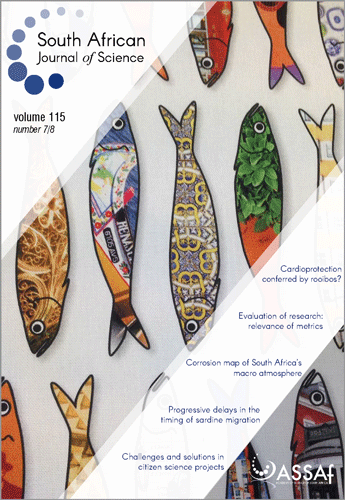Progressive delays in the timing of sardine migration in the southwest Indian Ocean
DOI:
https://doi.org/10.17159/sajs.2019/5887Keywords:
phenology, sardine run, sea surface temperature, ENSO, mid-latitude cyclonesAbstract
Phenological shifts represent one of the most robust bioindicators of climate change. While considerable multidecadal records of plant and animal phenology exist for the northern hemisphere, few noteworthy records are available for the southern hemisphere. We present one of the first phenological records of fish migration for the southern hemisphere, and one of the only phenological records for the southwest Indian Ocean. The so-called ‘sardine run’ – an annual winter migration of sardines, northeast of their summer spawning grounds on the Agulhas Bank off the coast of Durban, South Africa – has been well documented in local newspapers given the importance placed on fishing and fishing-tourism in the region. An analysis of the first arrival dates of sardines reveals a 1.3 day per decade delay over the period 1946–2012. Although this phenological shift reveals a poor association with sea surface temperatures (SST), it coincides with a poleward shift in the position of the 21 °C mean annual SST isotherm – the threshold temperature for sardine populations. The timing of sardine arrivals near Durban corresponds closely with the number of mid-latitude cyclones passing over the Durban coastline during the months of April and May. The strength of the run is strongly associated with ENSO conditions. The complex suite of factors associated with this phenological shift poses challenges in accurately modelling the future trajectory for this migratory event.
Significance:
- The sardine run, a significant event for tourism and fisheries, is occurring progressively later in the year.
- The incidence of failed sardine runs has increased in frequency over the period 1946–2012.
- These changes in fish migration phenology coincide with a poleward shift in the position of the 21 °C mean annual SST isotherm.
- The strength in the sardine run is strongly associated with ENSO conditions.
Published
Issue
Section
License

All articles are published under a Creative Commons Attribution 4.0 International Licence
Copyright is retained by the authors. Readers are welcome to reproduce, share and adapt the content without permission provided the source is attributed.
Disclaimer: The publisher and editors accept no responsibility for statements made by the authors
How to Cite
- Abstract 4180
- PDF 1137
- EPUB 212
- XML 442












.png)